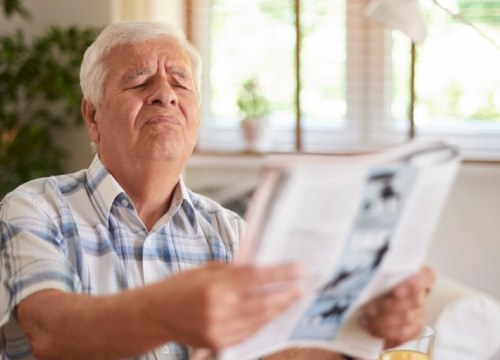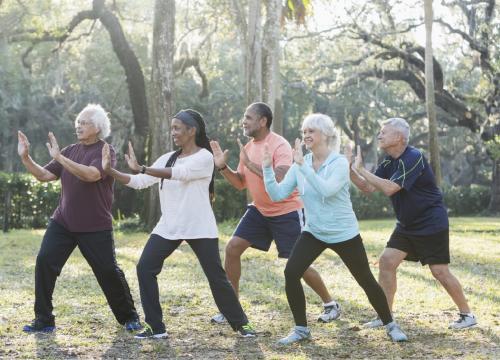La Importancia de la Fisioterapia y el Ejercicio
Tradicionalmente se pensaba que en las personas con trastornos degenerativos, el ejercicio tenía poco efecto, o que ¡hasta podía empeorar la enfermedad! Sin embargo, investigaciones recientes, tanto en modelos humanos como animales, sugieren que la fisioterapia—puede mejorar o mantener a raya los signos y síntomas de la enfermedad de Parkinson (EP, o PD, según sus siglas en inglés).
La marcha y el equilibrio
Las alteraciones de la marcha y el equilibrio son síntomas cardinales de la EP. Si no se tratan, pueden llevar a caídas, fracturas, hospitalizaciones y pérdida de independencia. Cerca de un 40% de las admisiones en centros de atención para la tercera edad son debido a caídas, mas frecuentes en personas con EP que en otros individuos.
En los últimos años, se ha investigado la mejoría de la marcha en personas con EP a través de ejercicios conocidos como “señalización externa” (cueing). Algunas veces tienen dificultades para generar “señales” internas que produzcan la orden de dar un paso, por tanto, pueden quedarse bloqueadas (inmovilizadas). Esto puede resultar en caídas y lesiones. Las “señales” externas: marcar el paso con un bastón, líneas horizontales en el piso, instrucciones de ayuda (pedirle a la persona que dé “pasos más largos”) o caminar al ritmo de un metrónomo, pueden mejorar la longitud de la zancada, la velocidad al andar y reducir el arrastramiento de los pies y la inmovilización o bloqueo.
En un estudio se utilizó el entrenamiento con “señales externas” para mejorar la marcha en el hogar de los participantes. Los resultados mostraron beneficios en el caminar y el equilibrio, menos episodios de inmovilización (bloqueo) y una mayor confianza para realizar actividades funcionales.
Sin embargo, tras terminar el entrenamiento, se perdieron las mejorías, recordándonos que es importante continuar haciendo ejercicio.
Cómo mejorar la fortaleza
Se ha mostrado que el ejercicio mejora el habla, la deglución (acto de tragar), la postura, el temblor, la destreza, la cognición y la depresión. Tambien se ha mostrado que el entrenamiento en cintas rodantes o caminadoras (treadmills) y el entrenamiento de resistencia de las piernas y el equilibrio, pueden beneficiar la fortaleza muscular, la marcha y el equilibrio.
Recientemente ha crecido el interés en las terapias diseñadas a aumentar la masa muscular, conocida como “hipertrofia muscular.” Existen datos indicando que los individuos que aumentan el tamaño múscular también experimentan mejorías en actividades funcionales como subir y bajar escaleras o mantener el equilibrio. Cuando los músculos no se usan, se encogen; por el contrario, con un intenso entrenamiento de resistencia, el tejido muscular aumenta en volumen. A medida que envejecemos, solemos volvernos más sedentarios y la pérdida muscular se hace inevitable—resaltando la necesidad de hacer ejercicio.
A finales de 1980, nuevas investigaciones mostraron que las personas mayores — muchas de ellas de 80-90 años y en hogares para la tercera edad — podían mejorar fortaleza, volumen muscular y funcionalidad con entrenamientos de alta resistencia. A pesar de estos descubrimientos—y debido a que algunos pensaban que el entrenamiento de resistencia podía aumentar la rigidez muscular — no se recomendaba el fortalecimiento para personas con EP por temor a que fuese dañino.
Datos recientes han desafiado esta manera de pensar. Un estudio de EP en etapas intermedias, muestra que el entrenamiento de alta resistencia aumenta el volumen muscular en un 6%, mejora un 17% la distancia que pueden caminar en seis minutos y mejora el descenso y ascenso de escaleras en un 22% y 13% respectivamente. Otro estudio indica que el ejercicio de alta resistencia de los músculos de las piernas mejora el equilibrio y reduce el número de caídas. Pese a que el ejercicio de resistencia tiene algunos riesgos (como hernias y lesiones músculo-esqueléticas), el no participar en tales programas y permanecer sedentario también conlleva riesgos.
El ejercicio y el cerebro en la enfermedad de Parkinson: estudios en animales
En la actualidad y basandose en estudios de modelos animales, la mayoría de investigadores creen que además de ayudar con el movimiento, el ejercicio puede influir sobre la progresión de la EP. Aunque no se conocen bien los mecanismos, se piensa que cuando una persona con Parkinson empieza una nueva actividad como, por ejemplo, un programa de ejercicios—especialmente si hay oportunidad de interacción social—pueden presentarse cambios en la estructura y función del cerebro.
El momento de iniciar un programa de entrenamiento después del diagnóstico de Parkinson también puede ser relevante. En estudios recientes, ratas parkinsonianas fueron forzadas a apoyar la extremidad impedida durante el ejercicio, mientras que la extremidad menos impedida se restringía con un yeso. Los animales que se ejercitaron inmediatamente después de la lesión parkinsoniana mostraron una mayor retención de las células nerviosas que producen dopamina y menos síntomas severos posteriores. Las ratas que empezaron el programa de ejercicios más tarde fueron peor: tuvieron síntomas más pronunciados de Parkinson y presentaron mayores daños cerebrales. En otras palabras, mientras más pronto se inicie el ejercicio, mejor.
En otro estudio animal, se mostró que el ejercicio, representado por medio de ratas corriendo en una rueda, aumentaba el número de nuevas neuronas productoras de dopamina, comparado con ratas sedentarias. En estos modelos animales el ejercicio parece tener un efecto neuroprotector del cerebro. Próximamente se realizarán estudios que muestren los efectos del ejercicio y la fisioterapia en la estructura y función cerebral de humanos con EP.
¿Qué quiere decir esto para las personas con la enfermedad de Parkinson?
Si se encuentra que los estudios animales se pueden aplicar a humanos, posiblemente la fisioterapia o un programa de ejercicios podría prevenir o demorar algunos de los aspectos incapacitantes de la enfermedad. No sabremos esto con seguridad hasta que se hayan hecho más estudios en humanos. Sí sabemos que es un buen consejo para las personas con la enfermedad de Parkinson que empiecen y continúen haciendo ejercicio y fisioterapia después del diagnóstico.
Muchos profesionales médicos aún no entienden su importancia. La educación de pacientes y familiares podría mejorar esta situación, al igual que una mayor disponibilidad de gimnasios y clubes de salud comunitarios que estén equipados para servir a poblaciones especiales, tales como personas con Parkinson. Es importante pedirle a su médico una remisión a un fisioterapeuta, ya que puede ser esencial para obtener la debida cobertura del seguro sanitario o Medicare.
Motivar a adultos mayores a que hagan ejercicio y se mantengan en forma requiere destrezas por parte del profesional de la salud. Se requiere un entrenador participativo con el fin de minimizar las lesiones, estar motivados y continuar el programa. Cualquiera que piense iniciar un programa de ejercicios debe consultar con su médico para cerciorarse de que es seguro.
Tanto personas jóvenes como mayores con EP pueden beneficiarse de fisioterapia y terapia ocupacional, o de un programa de ejercicios para hacer en casa. Ni la edad, ni la etapa de la enfermedad, deben considerarse factores limitantes en la decisión de hacer ejercicio. Los resultados de los estudios hasta la fecha son alentadores y el mensaje para las personas con Parkinson está claro: ¡busquen oportunidades para hacer ejercicio!
Para una lista de los estudios referenciados en este artículo por favor comuníquese con la Parkinson’s Foundation.
El Dr. David Lehman es profesor asociado de la State University of Tennessee y se especializa en neurorehabilitación y la enfermedad de Parkinson. Es el Presidente electo del MiddleTennessee Chapter de la American Parkinson Disease Association. El Dr. Mark A. Hirsch forma parte del profesorado del Departamento de Medicina Física y Rehabilitación del Carolinas Rehabilitation en Charlotte, NC y ha trabajado extensamente en terapiamotora. Es miembro de la Junta Directiva de la Parkinson Association de las Carolinas.
Si usted tiene o cree tener la enfermedad de Parkinson, consulte prontamente a un médico y siga sus indicaciones. Esta publicación no pretende sustituir el diagnóstico de la enfermedad de Parkinson, la receta de medicamentos, tratamientos u operaciones para la enfermedad de Parkinson de un médico.











